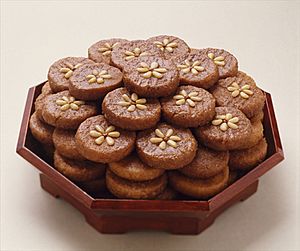Yakgwa facts for kids
 |
|
| Alternative names | Gwajul |
|---|---|
| Type | Yumil-gwa |
| Place of origin | Korea |
| Associated national cuisine | Korean cuisine |
| Main ingredients | Wheat flour, honey, sesame oil |
| 67.5 kcal (283 kJ) | |
| Korean name | |
| Hangul |
약과
|
|---|---|
| Hanja |
藥菓
|
| Revised Romanization | yakgwa |
| McCune–Reischauer | yakkwa |
| IPA | [jak̚.k͈wa] |
Yakgwa (약과; 藥菓) is a yummy Korean sweet treat. It is also known as gwajul (과줄). This special cookie is made from wheat flour, honey, and sesame oil. It also includes cheongju (a type of rice wine) and ginger juice.
Yakgwa is a hangwa, which means it's a traditional Korean confection. It is deep-fried to give it a unique texture. In the past, people often ate yakgwa during special events. These included jesa (family ceremonies for ancestors), chuseok (a harvest festival), weddings, and sixtieth-birthday parties. Today, you can find yakgwa in many places. It is a popular dessert in South Korea and can be bought in markets and supermarkets.
Contents
What Does Yakgwa Mean?
The name Yakgwa (약과; 藥菓) has two parts. The first part, yak (약; 藥), means "medicine." The second part, gwa (과; 菓), means "confection" or "sweet." So, Yakgwa means "medicinal confection."
This name comes from how much honey is used to make it. Long ago, Koreans believed that honey was good for your health. They thought it was like medicine. Because of this, many foods made with a lot of honey were called yak. That is why this sweet cookie got its special name.
The History of Yakgwa
Yakgwa has a very long and interesting history in Korea.
Early Beginnings
People first started making yakgwa for Buddhist ceremonies. This was during the Later Silla period, which lasted from 668 to 935 AD. It became very popular during the Goryeo Dynasty (918–1392). Royal families, noble people, temples, and even regular homes enjoyed this sweet. During the Goryeo era, yakgwa was even used in important events. For example, it was part of the pyebaek (a formal greeting) during wedding ceremonies for Goryeo kings and princesses from the Yuan dynasty.
Changing Shapes Over Time
When yakgwa was first made, it often looked like birds or animals. But during the Joseon era (1392–1897), its shape changed. It became flatter, which made it easier to stack. This was helpful for offering them in ceremonies.
Each pattern on yakgwa had a special meaning.
- Butterflies meant a happy marriage.
- Bats brought good fortune.
- Pine trees symbolized a new beginning.
- A lotus flower stood for harmony.
- A pomegranate meant fertility.
Later, the cookie was simplified into a round ball. However, these balls were not easy to present nicely for ancestral rites. So, the shape changed again, becoming a cube. Finally, yakgwa got its current look. It is now often round with pretty rippled edges.
Who Enjoyed Yakgwa?
In old Korea, yakgwa was mostly eaten by the upper classes. This was because wheat flour was rare and valuable. Honey was also considered a luxury. Today, yakgwa is much more common. It is often served with tea or given as gifts for special occasions.
How Yakgwa is Made
Making yakgwa involves several steps to create its unique taste and texture.
Preparing the Dough
First, wheat flour is sifted. Then, it is mixed with sesame oil, honey, ginger juice, and cheongju (rice wine). The flour and sesame oil are rubbed together by hand. This mixture is then passed through a sieve. Next, a sugar syrup is added. This syrup is made by boiling sugar and water, then adding starch syrup. The dough is kneaded, flattened into a sheet, and cut into shapes.
Shaping and Frying
Yakgwa can be shaped in different ways. Sometimes, it is pressed into special flower-shaped wooden molds. These molds are called yakgwa-pan (약과판). Other times, the dough is flattened with a mallet and cut into squares.
Yakgwa comes in different sizes:
- Dae-yakgwa is large.
- Jung-yakgwa is medium.
- So-yakgwa is small.
- The ones cut into squares or rectangles are called mo-yakgwa.
After shaping, the pieces are slowly deep-fried. They are cooked at a fairly low temperature, around 120–140 degrees Celsius (248–284 degrees Fahrenheit).
Soaking and Finishing
Once fried, the cookies are soaked in a sweet honey mixture. This mixture often includes cinnamon powder. Soaking gives yakgwa its sweet taste and a soft, moist texture. Finally, the treat might be sprinkled with toppings. Common toppings include pine nuts or sesame seeds.
See also
 In Spanish: Yakgwa para niños
In Spanish: Yakgwa para niños

